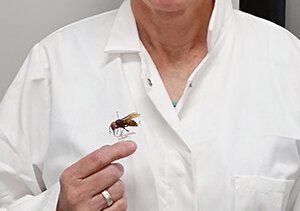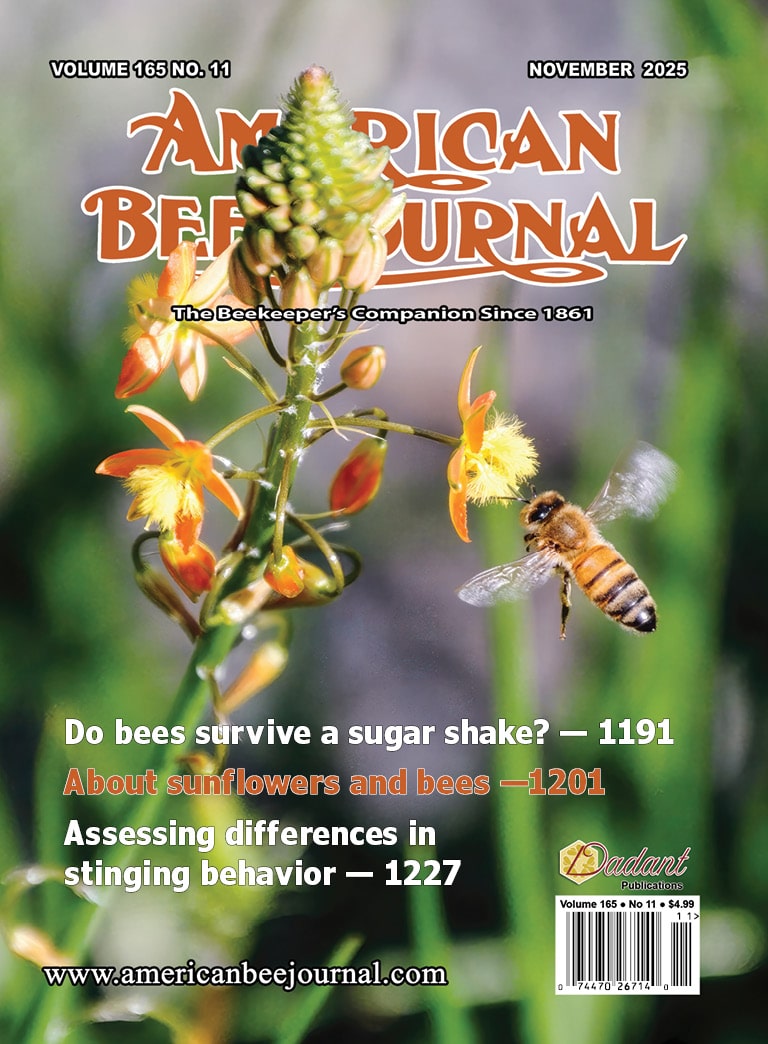
— University of California Davis, — May 5, 2020
It’s “ridiculous” to call the Asian giant hornet recently found in British Columbia and Washington state “the murder hornet,” says noted UC Davis wasp expert and researcher Lynn Kimsey, director of the Bohart Museum of Entomology and professor of entomology, UC Davis Department of Entomology and Nematology.
“It’s no more likely to sting and kill a human than a honey bee,” said Kimsey, a two-term past president of the International Society of Hymenopterists, an organization that studies bees, wasps, ants, and sawflies.
“Actually it’s less likely, as honey bee venom packs quite a punch and it is exclusively designed to defend against vertebrates,” she said.
“The colony everyone is hyperventilating over was actually found on Vancouver Island, British Columbia, last September when it was destroyed and then a single, dead hornet was found in December in Blaine, Washington,” Kimsey said. “There is no evidence that there are any more hornets in the vicinity of Vancouver or anywhere else on the West Coast.”
A colony of the Asian giant hornet (AGH), Vespa mandarinia, was found and destroyed Sept. 18, 2019 in Nanaimo, Vancouver Island, and the single dead hornet was found Dec. 8, 2019 in Blaine.
These were the first detections of this species in North America, but there may be more, according to the Washington State Department of Agriculture (WSDA). Beekeepers have reported “observations” (which may or may not be the same species) dating back to October 2019, WSDA says.
Twenty Asian giant hornet (AGH) specimens are housed in the Bohart Museum of Entomology, home of a global collection of nearly 8 million species. The largest one, a queen, measures about an inch and a half long, Kimsey said.
Meanwhile, entomologists are bemoaning the name “murder hornet” and the sensationalism and fear-mongering ensuing.
“It’s a bloody dumpster fire,” said entomologist Stephane De Greef, administrator of a newly created Facebook page, “Is This a Murder Hornet?”
“Some poorly-worded media reports about Asian Giant Hornets have triggered a veritable avalanche of nonsense online, but I can help set the record straight,” wrote senior museum scientist and hymenopterist Douglas Yanega of UC Riverside Entomology Research Museum.
“One colony was found and exterminated in Nanaimo on Vancouver Island in September of 2019, with a few sightings associated,” Yanega wrote. “One wasp believed to be from that colony was found — dead — on the U.S. side of the border near Nanaimo in December. Right now, all the authorities are doing is asking people to keep their eyes peeled JUST IN CASE there were queens that escaped the destruction of the Nanaimo nest, and established their own nests nearby. I was one of the authorities brought in to consult on this case, and to my knowledge there have not been any sightings in 2020 that would suggest the eradication attempt was unsuccessful. Put bluntly, as far as we know, there are no Asian giant hornets alive in either the U.S. or Canada as of 2020, and if there are, then they would be in the immediate vicinity of Vancouver Island (about a 50 mile radius or so).”
Said Kimsey: “A decade or more ago there was a colony of another species, Vespa asiatica, reported near the Port of Long Beach but nothing ever came of that either. A European species, Vespa crabro, was introduced into the East Coast perhaps a century ago and it is now fully established in the southeastern U.S.”
Kimsey says insects often come in cargo boxes from Asia to U.S. ports, establish colonies, and expand their range.
A soon-to-be-published article in the Entomological Society of America’s journal, “Insect Systematics and Diversity,” promises to shed more light on the genus and the history of introductions in the United States. Kimsey and colleagues Allan Smith-Pardo of the USDA and James Carpenter of the America Museum of History, New York, co-authored the review article.
In the abstract, the authors define Vespa as social wasps that are “primarily predators of other insects, and some species are known to attack and feed on honey bees, Apis mellifera, which makes them a serious threat to apiculture.”
“Vespa nests can be physically large, with over 1,000 workers, but usually with hundreds of workers,” they wrote. “Nests can be aerial, attached to tree branches or in shrubs, in crevices, under eaves or underground depending on the species. Depending on the latitude, nests can be either annual, started by a new queen every spring, or perennial, where young queens take over from old ones. Colonies in warm tropical climates tend to be perennial.”
Washington State University Extension has published an AGH fact sheet, the work of the husband-wife team of Susan Cobey, bee breeder-geneticist, and Timothy Lawrence, county director of Island County Extension (both formerly of UC Davis), and also Mike Jensen, county director of Pend Oreille. (See https://bit.ly/2SA3TxS)
The WSU scientists wrote that AGH “is the world’s largest species of hornet, native to temperate and tropical Eastern Asia low mountains and forests. The hornet is well adapted to conditions in the Pacific Northwest.”
“The primary purpose of venom is defense against predators by inflicting pain and damage,” they wrote. ”Vespa mandarinia is one of the two most venomous known insects in the world. The amount of venom each wasp delivers (4.1 µl/wasp) has designated V. mandarinia as the most venomous insect. In comparison, the honey bee has about 0.6µl/bee. When foraging for food in spring, the AGH is not highly defensive — unless its nest is disturbed. Late summer and fall, with the high demand for protein, they become very aggressive when attacking or occupying a honey bee colony.”
“It is critical that we identify, trap, and attempt to eliminate this new pest before it becomes established and widespread,” they wrote. “Attempts to contain the spread and eradication of this invasive insect will be most effective in trapping queens during early spring before their nests become established. Finding the nests can be a bit of a challenge. Their nests are typically in the ground though they can also be found under overhangs and within wall voids. The AGH is a strong flier and often will fly up and away and have an extensive flight range. Thus tracking can be difficult.”
They advise residents to “proceed with extreme caution and contact WSDA immediately. Do not try to exterminate the nest yourself.”
Cobey, who examined specimens in Japan last December and shipped some to WSU, commented this week that …


